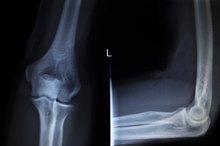A pulled muscle in the back commonly affects the quadratus lumborum. This large, triangular-shaped back muscle is responsible for movement of the spinal column, so muscle strain here results in obvious symptoms that restrict mobility. While back strain symptoms are similar to those caused by pulled muscles in other parts of the body, the size and location of the quadratus lumborum heighten the consequences. It may take substantial force to damage this thick muscular tissue, which will require greater time and effort for recovery.
If you are experiencing serious medical symptoms, seek emergency treatment immediately.
Pain
Back pain at the moment of overexertion is common. The pain may be severe enough to cause a break in activity, or it may be vague and grow over the next few hours. The University of Buffalo Sports Medicine group reports that the physical sensations may include a popping sound or burning feeling in quadratus lumborum 1. Acute pain usually lasts about two days and may recur in waves thereafter to a lesser extent.
- Back pain at the moment of overexertion is common.
- The pain may be severe enough to cause a break in activity, or it may be vague and grow over the next few hours.
Spasms
Pulled Back Muscle Symptoms
Learn More
While strain-induced muscle spasms or cramps can hurt, they indicate that healing has already begun. Following severe back strains, the body may try to immobilize the area to reduce shock and allow self-repair to begin. The University of Maryland Medical Center relates that back spasms represent this type of effort 2. These symptoms should pass in a matter of minutes but may recur later.
- While strain-induced muscle spasms or cramps can hurt, they indicate that healing has already begun.
- Following severe back strains, the body may try to immobilize the area to reduce shock and allow self-repair to begin.
Heat
Inflammation is another healing response by the body to muscle strain. As the Cleveland Clinic reports, increased blood flow to the pulled muscle creates symptoms of warmth radiating from beneath the skin and redness in the local area.
Swelling
Torn Tendons & Ligaments From Hyperextension
Learn More
Increased activity by the white blood cells around the back strain site causes fluid to leak into the muscle tissue. The Cleveland Clinic notes that this action is behind symptoms of swelling, which may be mild or severe. The presence of swelling means that the muscle strain is in its acute phase and vulnerable to further injury.
Weakness
A muscle strain separates the muscle fibers to some degree, in some cases creating a complete tear or rupture. Any tissue separation degrades the strength and functionality of the muscle. Symptoms of weakness, limited range of motion and limited ability to support the weight of the back are listed as common results of back strain by the National Institutes of Health 4.
Soreness
Due to the slow recovery time of large pulled muscles such as the quadratus lumborum, soreness may linger for as long as three months. The National Institutes of Health notes that this residual pain symptom is a reminder to work within limits until rehabilitation is complete 4. Returning to strenuous activity amidst muscle soreness can create a relapse or chronic back problem.
Related Articles
References
- University of Buffalo Sports Medicine: Strains
- Maryland Spine Center: Low Back Pain Overview
- Cleveland Clinic: Inflammation, What You Need to Know
- National Institutes of Health: Sprains and Strains
- Chou, R., Pharmacological management of low back pain. Drugs. March 2010.
- Low Back Strain and Sprain. American Association of Neurological Surgeons Patient Information website. Last Update Sept. 2005.
- Back Strain Treatment. Medline Plus Encyclopedia. Last updated: Oct 2005.
- Bernstein, et. al. The use of muscle relaxant medications in acute low back pain. Spine. June 2004.
- Magee, D.J. Orthopedic Physical Assessment. 4th edition. Saunders Elsevier. 2006. St. Louis, Mo.
Writer Bio
Nancy Clarke began writing in 1988 after achieving her Bachelor of Arts in English and has edited books on medicine, diet, senior care and other health topics. Her related affiliations include work for the American Medical Association and Oregon Health Plan.









